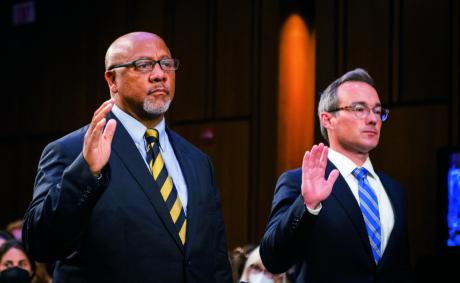Chris Bail was 10 or 11 when his family moved to what was then called the French Congo (now the Republic of the Congo). His father, who worked for the World Health Organization, was helping direct the country’s response to the HIV/AIDS epidemic.
Suddenly, an upper-middle-class white kid from suburban Boston found himself in a dirt-floor school in Brazzaville, where he spoke too little French to keep up. Goodbye, Nintendo; hello, snakes.
The nearest United Nations school was across the Congo River in a war zone. So, his parents hired a tutor – an Oxford-educated economist who had returned to the Congo but couldn’t find work, just as the country teetered on the precipice of economic and civil collapse. After a hiccup, Bail’s education continued. There were academic lessons, of course, but they were followed by long riverside walks, rich with perspective-broadening conversations.
“I think the social scientist in me was born then,” says Bail, now a professor of sociology at Duke.
But first, trauma. Still a child, Bail had been thrust into societal conflict. Dad was arrested at one point. Mom nearly died. Young Chris, home alone, hid in a closet during a break-in. He turned deeply cynical, and a rift grew between father and son. Yet eventually, years later, Bail found a familiar hope within him – one he now suspects he inherited.
Bail serves as director of the Polarization Lab at Duke and co-founder of the Summer Institutes in Computational Social Science, and he is the author of “Breaking the Social Media Prism: How to Make Our Platforms Less Polarizing,” published in 2021. He studies societal conflict and extremism as expressed and exacerbated by social media, and he pushes for solutions. Indeed, he received word in October that Twitter will be implementing one of the recommendations from his book — boosting posts that appeal across partisan divides.
For someone who tangles with the demons of extremism and polarization, though, Bail carries himself as authentically optimistic. As a parent, an academic and a human, it’s the least he can do.
“There’s a ton of work to do and I’m still really worried. The optimism comes from a place of ‘What else are we going to do?’” Bail says. “I don’t want to be the generation that did nothing.”
The biggest something, and Bail’s most substantial source of hope, stems from sharing his toolkit as broadly as possible. Bail and Princeton sociology professor Matt Salganik co-founded SICSS in 2017 to expand the computational social science field. (Salganik has since stepped back from a leadership role.)
“I don’t think it’s crazy to call it a paradigmatic shift in the way social science is done,” says Bail.
He knows the preconceptions about sociology: A researcher talks to a few people, shares some stories, but this isn’t serious and it isn’t science. Science is what grown-ups do with math. Computational social science, though, brings the math. It backs up social science findings with massive data sets and machine learning.
“I even think computational social science is going to make us better at asking scientific questions, because when we use tools like machine learning to analyze science, we can learn to see the patterns of what hasn’t been done yet,” Bail says.
Computational social science was taught in only four or five places in 2017, when Bail and Salganik hosted the first Summer Institute at Princeton. Participants have gone on to teach at institutions such as MIT, the University of Chicago and Oxford. Every summer since 2017, the program has grown, and it is now offered at 53 sites around the world (plus its virtual incarnations).
When Naniette Coleman, a Ph.D. candidate in sociology at the University of California Berkeley, attended her first SICSS session at Princeton, she was one of three Black participants. Bail’s philosophy, though, is that every new site is owned and directed by the people at that location. Accordingly, Coleman founded a site at Howard University that focuses on anti-Black racism and inequity.
“There are elements of this toolkit that are so freeing for communities that don’t have the ability to discuss, using data, the ways that they’re oppressed or challenged and fight for their own existence and their own voice,” says Coleman, who is now a member of the SICSS advisory board.
And there is no shortage of data. The growth is exponential. As Bail notes, more data was collected in the year 2012 than in all previous years of human history combined. Couple that with an explosion in machine learning, and he feels like he caught a wave. His peers, though, know computational social science and the growth of SICSS took an incredible amount of work, time and discipline. From the outside, it hardly looks like surfing.
Bail’s Ph.D. in sociology comes from Harvard, “which is not traditionally a super techy department,” says Duncan Watts, the Stevens University Professor at the University of Pennsylvania and a pioneer in the study of small-world networks. “He taught himself a lot of data science over the years.” Beyond that, Watts says, Bail built an institution that has spread worldwide, each site a discrete node, serving its distinct population.

More than his book or his research, even, Bail says SICSS is the biggest deal in his career. To build a community, to empower social scientists, is more than he thought he would ever achieve.
The flip side to this enthusiasm and optimism, however, is the ugliness and immediacy of the problems social scientists tangle with. For Bail, the monster in question is as ubiquitous as our smartphones.
“If we just sit back and wait for the story of social media to unfold, we’re going to have a pretty limited role in it,” he says.
Bail’s recommendation: Act soon. Tear these networks down. Start over.
According to anthropologists, humans can maintain meaningful relationships with only about 150 people, Bail says. Compare that to social media environments’ premise of connecting people, ad infinitum. We may not be wired to handle a crowd of that size.
“What if the whole structure of social media is wrong because we need to be seeing a society and not a string of messages?”
- Bail
“Our brains are designed to come into a setting, look around, ascertain who’s there, whether they’re looking at us, what is an appropriate thing to do? Who are our friends? Who are our enemies?” Bail says, gesturing around a Carrboro restaurant patio to illustrate. Storm clouds gather, as if on cue. Trees sway. Thunder rumbles.
“What if the whole structure of social media is wrong because we need to be seeing a society and not a string of messages?” Bail asks.
Viewed as a land you could navigate, he says, social media would look like this: There is a small group of angry people fighting over in one region, but the rest of the population is contentedly talking about music or sports or whatever pleases them. Yet the angry people are producing almost all the social media posts – 98 percent of the content on Twitter, Bail says. People looking at their feed would think the whole world is angry.
“What if I’m right and the news feed is inherently polarizing, leading to all manner of misperceptions?” Bail asks.
Working within the system can be problematic. One can research Facebook from within only on the social media giant’s terms, inevitably resulting in studies that conveniently exonerate Facebook of blame, Bail says.
But then he is hopeful again, as quickly as the sky clears after a summer storm. Bail is a social scientist, after all: “We actually know a lot about what creates strong, cohesive communities and what creates conflict, and it begs these questions about the architecture of social media,” he says. “We should be able to turn on and off features, but also build new environments.”
Bail’s ideas for new, less polarizing social media features are taking root, with Twitter making some improvements. But it has yet to turn off the “like” button or other features that drive status-seeking and bullying. Bail is pursuing more radical fixes in the Polarization Lab, which he co-runs with Sunshine Hillygus, professor of political science and public policy, and Alex Volfovsky, assistant professor of statistical science and computer science.
The lab is building an environment where any researcher can create a social media network and run experiments using it. Bail has built networks as well, such as one where users discuss polarizing issues anonymously, and he is reassured by the results.
“We’re early in the story of social media,” he says. “We have a chance to step back and say, ‘This isn’t working. What else would?’”
Yet Bail’s true strength is that he is not alone. Coleman studies social media, surveillance and privacy. Watts shares Bail’s interests in polarization and politics. And they are only two nodes in a global network of data science-empowered social scientists, all pulling toward a better world. Bail is not a leader in the traditional sense as much as he is a community-builder, a person who connects others, shares what he can, and then steps out of the way unless needed. He knows the challenges, but he believes in what he is doing.
“My publisher calls me a dystopian idealist, which is my favorite phrase,” Bail says, grinning.





